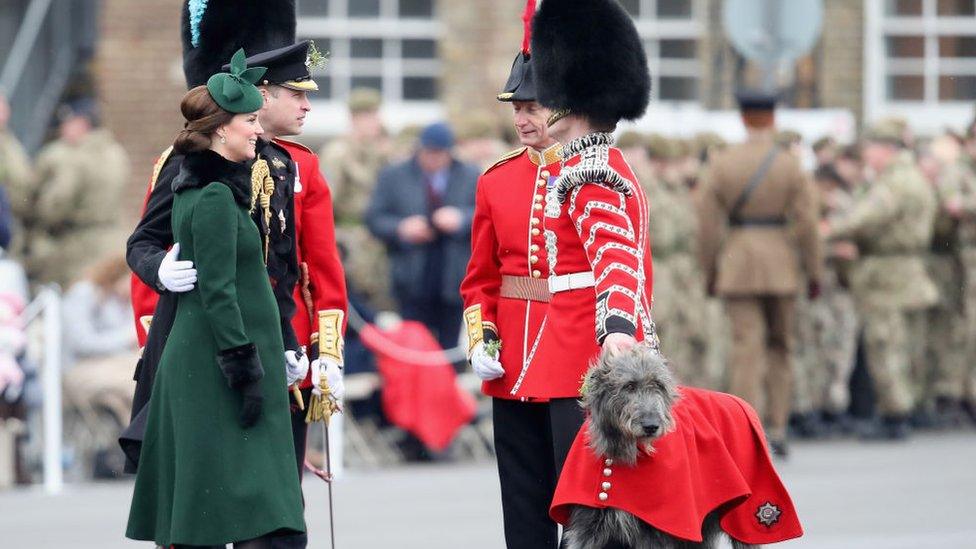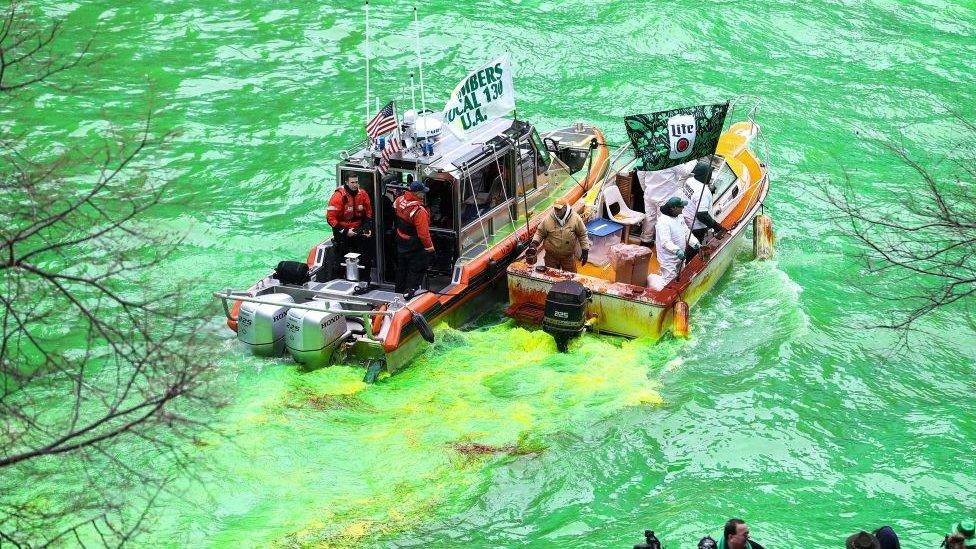St Patrick's Day: The patron saint who 'liked a drink'
- Published

Bedecked in green, the 2018 St Patrick's Day parade in Belfast was typical of how the day is celebrated
St Patrick's Day is celebrated across the world by Irish people, their descendants and anyone else who wants to join in.
The day, known in the modern era for huge parades, turning things green and having a drink, has, on occasion, led to excess.
However, it seems that a little tipsiness has always been the way to remember the saint.
The Book of Armagh, from the 9th Century, said all Irish monasteries and churches were to celebrate Patrick with three days and nights of feasting.
The great Irish folklorist Kevin Dannaher described the St Patrick's Day of 300 years ago.
"In most parts of Ireland the men repaired to the local tavern after church to the drink the 'pota Pádraig' or 'St Patrick's pot'. Seldom did the drinking stop at one pot."
Though he did write that "drowning the shamrock... by no means implies that it is necessary to get drunk in doing so".
St Patrick 'liked a drink'
But where did the association between saint and alcohol come from?
Stiofán Ó Cadhla is a senior lecturer in folklore and ethnology in University College Cork.
He said that folklore indicates that St Patrick himself liked to have a drink.

St Patrick's Day now sees huge parades celebrating Irish culture but that was not always the case
"One of the narratives associated with him is about 'peaca an tomhais'… the 'sin of mismeasure' when St Patrick enters a public house and orders his pint.
"The publican gives him the drink but he has left the drink shorter than he should, he doesn't give him his full measure.
"Patrick corrects him and tells him: 'You haven't realised that this sin of mismeasure is one of the worst sins that you can commit'."
Diarmuid Ó Giolláin, professor of anthropology at the University of Notre Dame in Indiana, USA, said St Patrick's Day has always been marked not only because it was a celebration of the patron saint but also because a dispensation allowed the Lenten fast to be broken - meat to be eaten and alcohol drunk - whilst Christians everywhere else were fasting.

Who was St Patrick?
Saint Patrick is the patron saint of Ireland, he lived in the 5th century AD and is understood to have played a major part in converting the Irish to Christianity.
While St Patrick really existed, and some of his writings survive, his value does not really come from historical details but from the inspiration of a man who returned to the country where he had been a child slave, in order to bring the message of Christ.
He is traditionally associated with the shamrock plant, which he used to explain the Christian doctrine of the Holy Trinity.

Diarmuid Ó Giolláin explained that drinking on St Patrick's Day was an important aspect of the religious festival and "a break in the rigours of lent".
Stiofán Ó Cadhla points out that St Patrick's Days falls close to the Spring Equinox.

Belfast's Holyland is home to many students and has seen trouble on St Patrick's Day in the past
"You can expect exuberance at this time of year," he said.
"It is tied up with the time of the year and the return to growth, everyone wanted to have their potatoes planted on St Patrick's Day.
"Drowning the shamrock in St Patrick's pot, that is to say putting your shamrock in a drink, is one of the most traditional ways of celebrating.
"John Carr wrote in the early 19th century… that around this time of the year the country people assemble and get very tipsy, they walk through the streets wearing the shamrock in their hats, whiskey is drank in copious libations, and the merry devotees continue until the greater part of the next day in honour of Sheelagh, St Patrick's wife," he said, adding that St Sheelagh is now mostly forgotten today.
Beginnings of change
Dr Ó Cadhla added that when the Catholic Church regrouped in Ireland in the wake of the potato famine it took the opportunity to clamp down on some traditional practices around the saint.
"St Patrick's Day would have been associated with fair days and large gatherings of people in certain locations and at certain wells.
"The church step in… asserting themselves, and trying to wean the people off some of those ideas.
NI celebrates St Patrick's Day in 2018
"They don't succeed 100%."
Traditional belief systems and the Catholic tendencies have come to an accommodation. combining to become a folkloric belief and behaviour, he explained.
There were always concerns that some of the behaviour surrounding the festival "did not fit in with the strict idea of St Patrick", Dr Ó Cadhla said:
"There is Saint Patrick of the hagiographers [people who write about the lives of saints] but of course there is Saint Patrick beloved of Irish people, who is like one of themselves.
"Of course, St Patrick understands and loves the Irish people and is one of them in this celebration."
The parades
Dr Ó Cadhla said that the great public parades connected with the patron saint are a relatively recent thing, in Ireland at least.
"I think people of a certain age will recall how poorly patronised those parades were and how people really didn't tend to take them that seriously."

Catherine, Duchess of Cambridge and Prince William, Duke Of Cambridge attend the annual Irish Guards St Patrick's Day Parade
He suggested that the parades may have a military origin and that British Army bands would have come out and paraded in the 19th Century.
The British Army's Royal Irish Regiment celebrates St Patrick's Day to this day, as do the Irish Defence Forces.
'American razzmatazz'
However, he stressed that the "formal, militaristic" nature of today's parades are greatly influenced by Irish America.
Prof Ó Giolláin agreed - he said changes in Irish society and globalisation have led to huge change in how St Patrick's Day is celebrated in Ireland.
"I think the model has been the American St Patrick's Day celebrations, the American razzmatazz."

Chicago River is turned green for the 2018 St Patrick's Day in Chicago, United States
He sees the day as having moved away from the concept of a national day, away from church and state patronage, to representing a global dimension of Irishness.
"It has been taken as an opportunity to tourism but also to promote Ireland as a country which is more diverse and more open to the world," he said.
"The change reflects changes in Irish society."
- Published17 March 2018